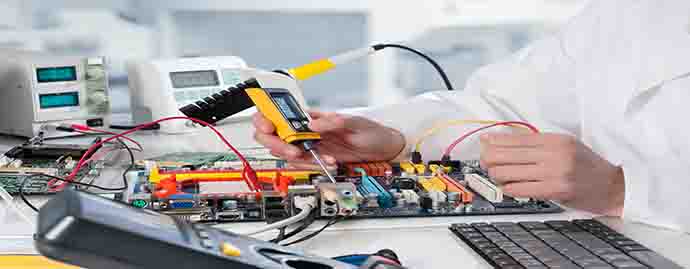| تاريخ البداية | تاريخ النهاية | الدولة | المدينة |
|---|

 +۹٦٦ ۹۲۰۰۰۷۷۷۱
+۹٦٦ ۹۲۰۰۰۷۷۷۱

الأهداف
At the end of the course participants will able:
- Identify the different types of motors and their appropriate applications
- Test for & troubleshoot motor problems
- Properly select and replace a motor
- Keep a motor properly maintained
- Identify & understand symbols used in common control circuit drawings
- Use a logical, systematic approach to troubleshooting
- Find and fix common control circuit problems
- Understand the technology, concepts and terminology of Electrical Motors.
- Recognize different types, theory of operation, components and accessories of Electrical Motors.
- Specify correctly any type of Electrical Motors for certain applications.
الخطوط العريضة
Day 1:
DC & AC MOTOR BASICS
- Motor terminology
- Types of motors and their suitable applications
- DC Motors
- Induction Motors
- Synchronous Motors
- Stepper Motors
- Special Motors
- Testing equipment
- Field troubleshooting checklist
- Motor selection
- Nameplate data
- Motor ratings
- Energy considerations
Day 2:
SPEED CONTROL OF DC & AC MOTORS
- Introduction to variable speed drives
- Classic control of DC shunt motor
- Classic control of DC series motor
- Classic control of DC compound motor
- Modern control of DC shunt motor
- Modern control of DC series motor
- Modern control of DC compound motor
- Classic control of 3-phase induction motor ( squirrel & slip ring)
- Modern control of 3-phase induction motor ( squirrel & slip ring)
- Designs of variable speed drives
Day 3:
PROTECTION OF DC & AC MOTORS
- Protective devices
- Thermal overload for DC & AC motors
- Over current/overload for DC & AC motors
- Under-voltage/over-voltage for DC & AC motors
- Under frequency for AC motors
- Current unbalance or negative phase sequence for AC motors
- Earth fault protection for DC & AC motors
- Stall protection/acceleration time/start up supervision
- Voltage controlled or restrained over current
- Protection settings
Day 4:
TROUBLESHOOTING MOTORS
- Most Common Motor Problems
- Electrical Problems
- Testing Windings for Shorts, Opens and Ground Faults
- Phase Unbalance
- Mechanical Problems
- Phase Rotation Testing
Day 5:
SAFETY ISSUES WHEN TROUBLESHOOTING OR REPLACING MOTORS
- Hazards of rotating equipment
- OSHA Lockout/Tagout requirements
- Determining power supplies and voltages
- Verifying circuits de-energized – safely and correctly!
- Personal Protective Equipment (PPE) requirements
- Visual inspections
Day 6:
PROCEDURES FOR REPLACING A MOTOR
- De-terminating motors
- Setting replacement motors
- Shaft coupling/alignment options
- Electrical checks
- Sizing line conductors
- Using nameplate data for proper connections
- Selecting the best method of motor termination
- Lugs and insulation tapes for termination
- Termination kits
- Methods of verifying proper phase rotation
- Lubrication requirements
- Sizing fuses and overloads
- Final checks prior to re-energizing motor
- Electrical, visual and mechanical checks for startup testing
Day 7:
MOTOR MAINTEANCE
- Testing motor windings
- Megohmmeter testing of motors
- Modern, state-of-the-art predictive maintenance testing for motors
- Bearings and Lubrication
- Motor Storage
- Determining voltage and current imbalance and its effects
- Recommended maintenance practices of NFPA 70B
- Sizing and adjusting overloads per the NEC®
- Common motor problems and how to find them
- Modern, state-of-the-art predictive maintenance testing for motors
- Bearings and Lubrication
- Motor Storage
- Determining voltage and current imbalance and its effects
- Recommended maintenance practices of NFPA 70B
- Sizing and adjusting overloads per the NEC®
- Common motor problems and how to find them
- Fixes for common motor problems
- Fixes for common motor problems
Day 8:
FUNDAMENTALS OF CONTROL CIRCUITS
- Types of motor control
- Symbols for control
- Learn to read motor control schematic and ladder diagrams
- Watch motor control circuits operate on-screen before the class
- Learn the basics of PLC ladder logic
- Watch PLC ladder diagrams operate on-screen before the class
- Developing a logical, systematic approach to troubleshooting controls
- Typical control circuit problems and how to find and fix them
Day 9:
MOTOR DRIVES AND SPECIAL CONTROL CIRCUIT APPLICATIONS
- Energy Management and motor drives
- AC and DC drives overview
- Motors for Variable Speed Drives
- Variable Speed Drive Applications
- HVAC applications
- Servo motors and drives for manufacturing
- Review operation of modern automation control such as &pick and place& and conveyor drives
Day 10:
TROUBLESHOOTING CONTROL CIRCUITS
- Relays, Motor Starters and Control Devices
- Reading and Interpreting Ladder Diagrams
- Power Loss
- Control Circuit Industrial Applications
- Electric Motor Drives
- Solenoid-Operated Valves
- Heating Elements
من ينبغى أن يحضر
- Electrical Design engineers
- Electrical New graduate engineers
- Site field engineers
- Maintenance engineers
- Electrical technicians.
المدة
10 أيام










